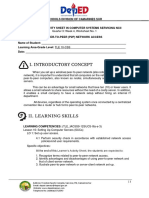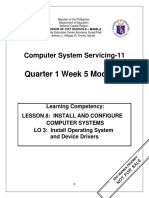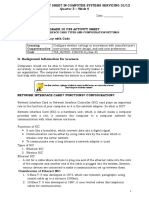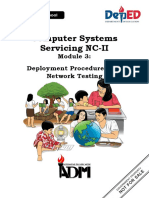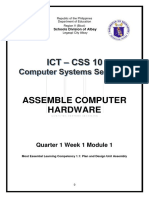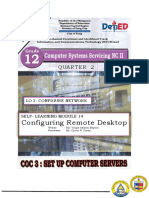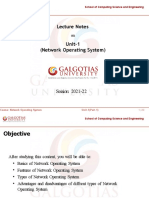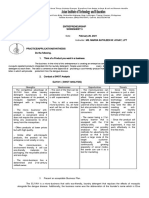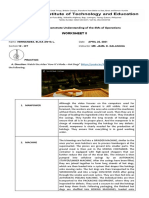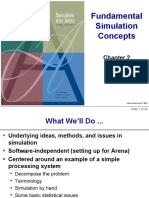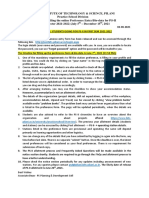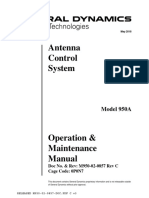Read the Information Sheet 6.
1 carefully and at the end of
this sheet there will be a Self-check to measure how much
you’ve learned and remembered.
INFORMATION SHEET No. 6.1
NETWORK OPERATING SYSTEM (NOS)
Learning Objectives:
After reading this Information Sheet, you should be able to:
Define network operating system (NOS),
Identify the different types of network operating system,
Differentiate the Peer to Peer and Client-Server operating system
What is a Network Operating System?
Network Operating System is a computer operating system that
facilitates to connect and communicate various autonomous computers
over a network. An Autonomous computer is an independent computer
that has its own local memory, hardware, and O.S. It is self-capable to
perform operations and processing for a single user. They can either run the
same or different O.S.
The Network O.S. mainly runs on a powerful computer, that runs the server
program. It facilitates the security and capability of managing the data,
user, group, application, and other network functionalities. The main
advantage of using a network o.s. is that it facilitates the sharing of
resources and memory amongst the autonomous computers in the network.
It can also facilitate the client computers to access the shared memory and
resources administered by the Server computer. In other words, the Network
O.S. is mainly designed to allow multiple users to share files and resources
over the network.
Computer System Servicing
G12 – Technical-Vocational-Livelihood (TVL) Track Page 1
The Network O.S. is not transparent in nature. The workstations connected
in the network are aware of the multiplicity of the network devices. The
Network Operating Systems can distribute their tasks and functions
amongst connected nodes in the network, which enhances the system
overall performance. It can allow multiple access to the shared resources
concurrently, which results in efficiency. One of the major importance of
using a Network O.S. is remote access. It facilitates one workstation to
connect and communicate with another workstation in a secure manner.
For providing security, it has authentication and access control
functionality. The network o.s. implements a lot of protocols over the
network, which provides a proper implementation of the network
functionalities. One drawback of Network O.S. is its tightly coupled nature
in the network.
Some examples of Network O.S. are Novel Netware, Microsoft Windows
server (2000, 2003, 2008), Unix, Linux, etc.
There are mainly two types of Network O.S., they are:
1. Peer-to-Peer
2. Client-Server
Peer-to-Peer Network Operating Systems allow users to share resources
and files located on their computers and to access shared resources found on
other computers. However, they do not have a file server or a centralized
management source (See fig. 1). In a peer-to-peer network, all computers are
considered equal; they all have the same abilities to use the resources
available on the network. Peer-to-peer networks are designed primarily for
small to medium local area networks. Nearly all modern desktop operating
systems, such as Macintosh OSX, Linux, and Windows, can function as peer-
to-peer network operating systems.
Following are the advantages of the Peer-to-Peer Network Operating
System:
1. Easy to install and setup.
2. The setup cost is low.
3. There is no requirement for any specialized software.
4. The sharing of information and resources is fast and easy.
Following are the disadvantages of the Peer-to-Peer Network Operating
System:
1. The performance of autonomous computers may not be so good when
sharing some resources.
2. There is no centralized management.
3. It is less secure.
4. It does not have backup functionalities.
5. There is no centralized storage system.
Computer System Servicing
G12 – Technical-Vocational-Livelihood (TVL) Track Page 2
Fig. 1. Peer-to-peer network
Client-Server Networking Operating System operates with a single server
and multiple client computers in the network. The Client O.S. runs on the
client machine, while the Network Operating System is installed on the
server machine. The server machine is a centralized hub for all the client
machines. The client machines generate a request for information or some
resource and forward it to the server machine. The server machine, in turn,
replies to the client machine by providing appropriate services to it in a
secure manner. The server machine is a very powerful computer, that is
capable of tackling large calculations and operations. It can also have the
ability to administer the whole network and its resources. It can be
multiprocessing in nature, which can process multiple client requests at the
same time. The Network O.S. enhances the reach of client machines by
providing remote access to other nodes and resources of the network in a
secure manner.
Client/server network operating systems allow the network to centralize
functions and applications in one or more dedicated file servers (See fig. 2).
The file servers become the heart of the system, providing access to resources
and providing security. Individual workstations (clients) have access to the
resources available on the file servers. The network operating system provides
the mechanism to integrate all the components of the network and allow
multiple users to simultaneously share the same resources irrespective of
physical location. UNIX/Linux and the Microsoft family of Windows Servers
are examples of client/server network operating systems.
Fig. 2. Client/server network
Computer System Servicing
G12 – Technical-Vocational-Livelihood (TVL) Track Page 3
Following are the advantages of the Client-Server Network Operating
System:
1. It has centralized control and administration.
2. It has a backup facility for lost data.
3. The shared data and resources can be accessed concurrently by
multiple clients.
4. It has better reliability and performance.
Following are the disadvantages of the Client-Server Network Operating
System:
1. The setup cost is very high.
2. There is a requirement of specialized software for client and server
machines to function properly.
3. There is a need for an administrator to administer the network.
4. There may be network failure, in case of central server failure.
5. A huge amount of client requests may overload the server.
Note: For further study watch this video presentation in youtube.com
Title: Network Operating System uploaded by Captain Android.
Here is the link: https://www.youtube.com/watch?v=y0x_dOkOU5o
Title: What is Peer to Peer (P2P) uploaded by Sense Chat.
Here is the link: https://www.youtube.com/watch?v=s-Fs_Ucy_EU&fbclid=IwAR1GiGDQS-
dxZJLyyqO6jvFqIj7ZvJpJ1hrxGawKL_25O6clUwrjfRdKDwI
Electronic references:
Network Operating System uploaded by Captain Android
https://www.youtube.com/watch?v=4_zSIXb7tLQ
Afteracademy.com - what-is-a-network-operating-system?
https://afteracademy.com/blog/what-is-a-network-operating-system
https://fcit.usf.edu/network/chap6/chap6.htm#:~:text=Peer%2Dto%2Dpeer%20network%20operatin
g,centralized%20management%20source%20(See%20fig.
Computer System Servicing
G12 – Technical-Vocational-Livelihood (TVL) Track Page 4
Self-Check 6.1
Multiple Choice:
Directions: Read the statement carefully and choose the correct answer for
each item. Write the letter of your answer on the space provided before each
number.
______1. It allows the network to centralize functions and applications in one or more
dedicated file server.
A. Peer to Peer C. Operating System
B. Client-Server D. Network System
______2. It is a computer operating system that facilitates to connect and
communicate various autonomous computers over a network.
A. Peer to Peer network C. Network Operating System
B. Windows operating D. Client-Server network
______3. It allows users to share resources and files located on their computers
and to access shared resources found on other computers.
A. Peer to Peer C. Operating System
B. Client-Server D. Network System
______4. It operates with a single server and multiple client computers in the
A. Operating System C. Peer to Peer
B. Client-Server D. Network System
______5. The two types of network operating system are;
A. Windows 7 and 10 C. Peer to Peer and Client-Server
B. Linux and Server D. Windows and Linux
TRUE OF FALSE
Directions: Read the statement carefully and choose the correct answer for
each item. Write T if the statement is True and F if the statement is False.
______6. Peer-to-Peer Network Operating System is easy to install and setup.
______7. There is no requirement of specialized software for client and server
machines to function properly.
______8. In Client-Server, there may be network failure, in case of central
server failure.
______9. Peer-to-Peer Network Operating System have a centralized
management of file services.
______10. In Client-Server, the shared data and resources can be accessed
concurrently by multiple clients.
Computer System Servicing
G12 – Technical-Vocational-Livelihood (TVL) Track Page 5





